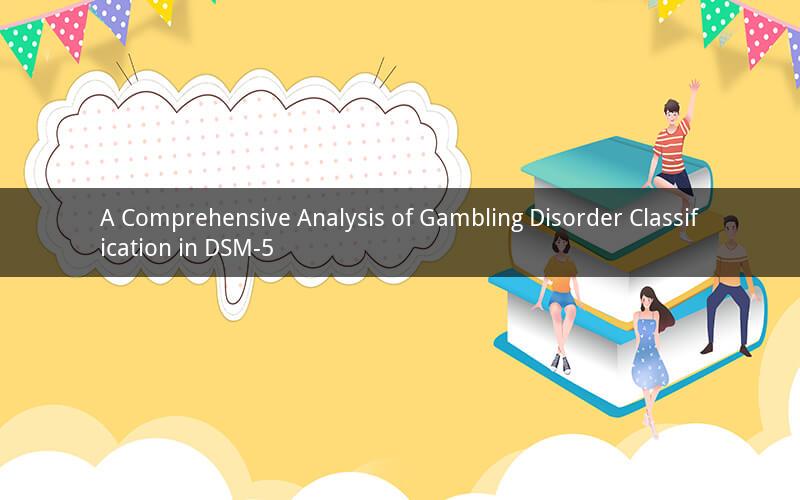
Gambling disorder has been a significant issue in modern society, affecting millions of individuals worldwide. The Diagnostic and Statistical Manual of Mental Disorders, Fifth Edition (DSM-5) has played a crucial role in the classification and diagnosis of gambling disorder. This article aims to provide a comprehensive analysis of the classification of gambling disorder in DSM-5, highlighting its key features, diagnostic criteria, and implications for treatment and research.
I. Background of Gambling Disorder
Gambling disorder, also known as pathological gambling, is a behavioral addiction characterized by the inability to control or stop gambling despite negative consequences. It is considered a mental health disorder due to its detrimental impact on an individual's psychological, social, and financial well-being. The concept of gambling disorder has evolved over time, with the DSM-5 representing the latest iteration of its classification.
II. Classification of Gambling Disorder in DSM-5
DSM-5 has redefined gambling disorder as an addictive disorder, placing it within the same category as substance use disorders. This classification acknowledges the similarities between gambling and substance use in terms of their addictive potential and the psychological and social consequences they can cause.
A. Key Features of Gambling Disorder in DSM-5
1. Impulse Control: Individuals with gambling disorder exhibit a lack of impulse control, leading to a preoccupation with gambling and a strong urge to continue engaging in the activity.
2. Repeated Attempts to Stop: Despite recognizing the negative consequences, individuals with gambling disorder repeatedly attempt to stop or control their gambling behavior without success.
3. Risky Behavior: They engage in risky behavior, such as borrowing money, taking out loans, or selling possessions to finance their gambling habits.
4. Continued Engagement: Despite experiencing significant problems, individuals continue to engage in gambling, often leading to worsening of their situation.
5. Relapse: Individuals with gambling disorder are prone to relapse, even after periods of abstinence.
B. Diagnostic Criteria for Gambling Disorder in DSM-5
DSM-5 provides a set of diagnostic criteria for gambling disorder, which include the following:
1. Preoccupation: The individual spends a significant amount of time thinking about gambling, planning the next gambling session, or reliving past gambling experiences.
2. Loss of Control: The individual is unable to control or stop their gambling behavior, despite repeated attempts.
3. Escape: The individual engages in gambling as a means to escape problems or negative emotions.
4. Chasing Losses: The individual continues to gamble in an attempt to recover previous losses, leading to further financial problems.
5. Lying: The individual lies to family, friends, or healthcare professionals about their gambling behavior.
6. Risky Behavior: The individual takes significant risks, such as borrowing money, taking out loans, or selling possessions to finance their gambling habits.
7. Consequences: The individual experiences significant problems in their personal, professional, or social life due to their gambling behavior.
III. Implications of Classification in DSM-5
The classification of gambling disorder in DSM-5 has several implications for treatment, research, and public awareness.
A. Treatment: The classification of gambling disorder as an addictive disorder has led to the development of various treatment approaches, including cognitive-behavioral therapy, motivational interviewing, and medication.
B. Research: The DSM-5 classification has facilitated research on gambling disorder, allowing for a better understanding of its etiology, prevalence, and treatment outcomes.
C. Public Awareness: The classification has increased public awareness of gambling disorder, leading to more individuals seeking help and support.
IV. Conclusion
The classification of gambling disorder in DSM-5 has been a significant advancement in the field of mental health. By recognizing gambling disorder as an addictive disorder, DSM-5 has provided a framework for diagnosis, treatment, and research. Understanding the key features, diagnostic criteria, and implications of this classification is crucial for healthcare professionals, researchers, and individuals affected by gambling disorder.
Questions and Answers:
1. Q: How does the classification of gambling disorder in DSM-5 differ from previous editions?
A: DSM-5 reclassifies gambling disorder as an addictive disorder, placing it within the same category as substance use disorders, highlighting the similarities between the two.
2. Q: What are the primary diagnostic criteria for gambling disorder in DSM-5?
A: The primary diagnostic criteria include preoccupation, loss of control, chasing losses, lying, risky behavior, and experiencing significant problems in personal, professional, or social life due to gambling.
3. Q: How does the classification of gambling disorder in DSM-5 impact treatment approaches?
A: The classification as an addictive disorder has led to the development of various treatment approaches, including cognitive-behavioral therapy, motivational interviewing, and medication.
4. Q: What are the implications of the DSM-5 classification for public awareness?
A: The classification has increased public awareness of gambling disorder, leading to more individuals seeking help and support.
5. Q: How can healthcare professionals use the DSM-5 classification to improve diagnosis and treatment of gambling disorder?
A: Healthcare professionals can use the DSM-5 criteria to accurately diagnose gambling disorder and implement appropriate treatment approaches, such as cognitive-behavioral therapy or medication, tailored to the individual's needs.